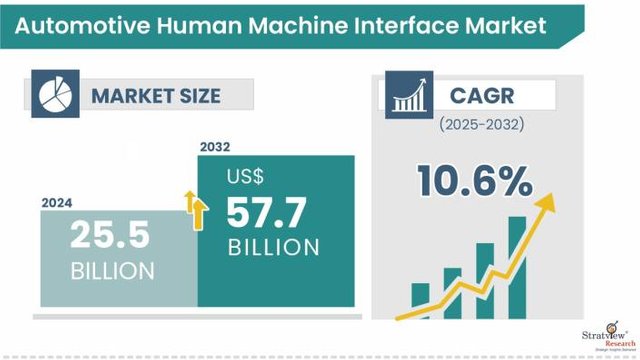The Evolution of Automotive HMI – Driving Toward Intuitive Interactions
The automotive industry is undergoing a profound transformation driven by connectivity, electrification, and autonomous technology. At the heart of this evolution lies the Human-Machine Interface (HMI)—the medium through which drivers and passengers interact with vehicles.
According to Stratview Research, the automotive human machine interface market was estimated at USD 25.5 billion in 2024 and is likely to grow at a CAGR of 10.6% during 2025-2032 to reach USD 57.7 billion in 2032.
Download the sample report here, to uncover in-depth insights.
https://stratviewresearch.com/Request-Sample/639/automotive-human-machine-interface-market.html#form
1. Connected Vehicles: The increasing integration of connectivity features—such as navigation, media streaming, and remote diagnostics—is pushing demand for advanced HMI systems.
2. Autonomous Driving: As vehicles shift control from humans to machines, HMIs are critical in providing situational awareness and enabling driver override functionality.
3. Consumer Expectations: With the influence of smartphones and smart homes, users now expect automotive HMIs to be responsive, personalized, and seamless.
Challenges in Implementation:
Despite its potential, the market faces key hurdles:
• Cognitive Overload: As more features are added to the dashboard, there’s a risk of distracting the driver.
• Cybersecurity: Connected HMIs are vulnerable to cyberattacks, necessitating robust security protocols.
• Legacy Integration: Many OEMs struggle to integrate modern HMI systems with older vehicle architectures.
Trends to Watch:
• Voice and Gesture Recognition: Hands-free interfaces are gaining ground to reduce distractions.
• AR-Based HUDs: Augmented reality is enhancing driver awareness through real-time visuals projected onto windshields.
• AI-Powered Personalization: HMIs are evolving to learn user preferences and habits, offering a tailored driving experience.
With HMI at the intersection of safety, user experience, and innovation, it is no longer just an accessory—it’s a strategic differentiator for automakers.
